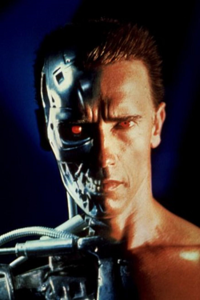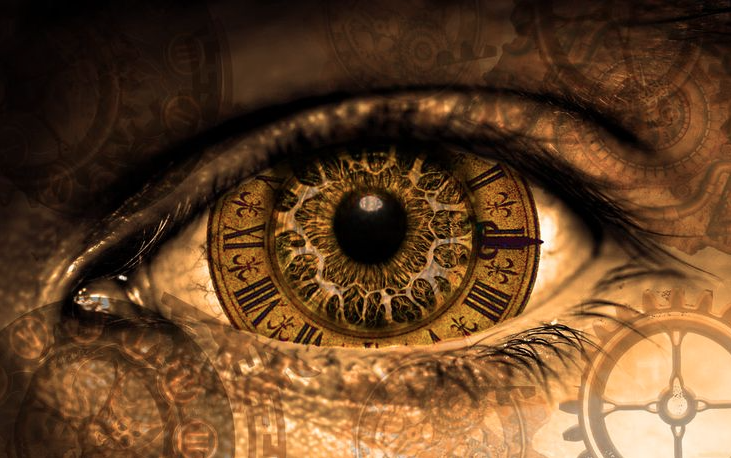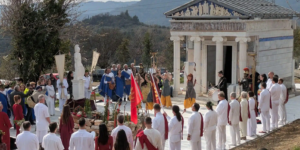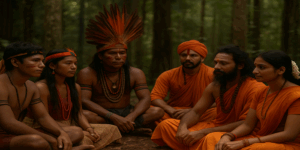 prakriti-stvam cha sarvasya guNatraya-vibhAvinI|
prakriti-stvam cha sarvasya guNatraya-vibhAvinI|
kAlarAtrir-mahArAtrir-mOha-rAtrischa dArunA||
‘O creatrix and primal cause who brings the three great qualities into effect, You are the dark night of periodic dissolution, You are the great night of final dissolution, and You are the terrible night of delusion’ (from DEvI mAhAtmyam, I:68, translated based on the text by Sw. Jagadiswarananda, Ramakrishna Math, Chennai)
The creator, BrahmA, praises the supreme Goddess (dEvI) in these words, when confronted by the terrible demons, Madhu and Kaitabha just when he was about to start his creation process. This was the mystic period before the advent of ‘time’, when the great Sustainer SrI MahA vishNu is in Yogic trance (yOga-nidrA) , an aeon that is hymned in the majestic verses of the Rig Veda (X:129 – famously commented upon by personalities such as Carl Sagan – verses 1-3 quoted with translation taken from here):
Then even nothingness was not, nor existence,
There was no air then, nor the heavens beyond it.
What covered it? Where was it? In whose keeping?
Was there then cosmic water, in depths unfathomed?
Then there was neither death nor immortality
nor was there then the torch of night and day.
The One breathed windlessly and self-sustaining.
There was that One then, and there was no other.
At first there was only darkness wrapped in darkness.
All this was only unillumined cosmic water.
That One which came to be, enclosed in nothing,
arose at last, born of the power of heat.
 Back in the Devi-Mahatmyam, BrahmA extols this primal darkness, the yOga-nidrA of VishNu as ‘vishvEshwarIm jagad-dhAtrIm’ or the ‘queen of the cosmos and supporter of the worlds’.
Back in the Devi-Mahatmyam, BrahmA extols this primal darkness, the yOga-nidrA of VishNu as ‘vishvEshwarIm jagad-dhAtrIm’ or the ‘queen of the cosmos and supporter of the worlds’.
What is fascinating to note in these verses, is that time is implicitly taken to be vast and cyclical in nature, with universes potentially existing in a meta-space beyond the ordinary experiential space-time, which is the abode of the great Gods. Within the domain of consciousness, time is a marker of only one mode, namely that of ‘existence’ or the phenomenon. This attribute of the great Gods (mahA-dEvAs) to exist beyond ‘time’, occurs routinely in many other hymns, for example, in the much loved GaNapati Atharva-shiras, the great God GaNesha is hailed as:
tvam guNa-trayAtrItah, tvam avasthAtrayAtItah
tvam dEha-trayAtItah, tvam kAla-trayAtItah
(You are beyond the three qualities sattva rajas and tamas, beyond the three states of waking, dream and deep sleep, beyond the three envelopes of phsyical, mental and spiritual and beyond the three times i.e. past, present and future).
The foundational texts of Vedanta and MahAyAna, ask the practitioner to examine the nature of the arrow of time, and recognize how consciousness or ‘such-ness empty of all identifications’ underlies the changing tenses as a sort of ‘eternal present’. Past and Future, are thought to be sets of choices and possibilities respectively, and discovering the underlying consciousness is the key to transcending them. SAnkhya, the most ancient of Hindu philosophical systems, holds that the Gods of the present time cycles are in fact great Yogis of previous cycles.
 They became so powerful, and yet did not annihilate their individuality and thus gained a merger into Prakriti, the primordial creatrix herself. Such ‘prakriti-leena-purushas’ in fact re-remerge as lords over new cycles of creation (see Swami Vivekananda’s Jnana Yoga for more details on this).
They became so powerful, and yet did not annihilate their individuality and thus gained a merger into Prakriti, the primordial creatrix herself. Such ‘prakriti-leena-purushas’ in fact re-remerge as lords over new cycles of creation (see Swami Vivekananda’s Jnana Yoga for more details on this).
This type of trans-creation is ascribed not only to the Gods, but also to great sages: Srimad-Bhagavatam gives a similar origin story for the divine sage Narada, who is said to have attained rishi-hood in a previous cycle of creation, emerging as a fully-enlightened sage in the present. There is a fascinating story narrated in the Yoga-Vashistha, where the crow BhusundI is said to have been a great yoga adept, and rAmA recognizes and explains to lakshmaNa how this crow had survived a cycle of dissolution, re-emerging in the present universe.
There is almost nothing in the scriptural and traditional sources that support such a self-defeating view of man’s destiny. On the contrary, time is viewed as an immense canvas of possibilities, where complex Karmic paths can be woven out, hewing destinies out of darkness, anticipating the discoveries of modern science.
 The complex Hindu view of time finds an excellent depiction in the short-lived but enduringly appealing Science Fiction series Andromeda (conceptualized by Gene Roddenberry, the creator of Star Trek, but picturized after his death by his widow Majel Barrett).
The complex Hindu view of time finds an excellent depiction in the short-lived but enduringly appealing Science Fiction series Andromeda (conceptualized by Gene Roddenberry, the creator of Star Trek, but picturized after his death by his widow Majel Barrett).
In this show, the Stars that lie at the heart of planetary systems are thought to have personalities or ‘Avatars’ which live through huge cycles of time, and have extraordinary powers that humans can only dream of achieving, including choosing between various possible ‘timelines’, so that a certain outcome that is best of for everyone is manifested. Before such titanic personalities, human lives and desires appear puny.
The Devas and Lokapalas of the Hindu pantheon fulfill a similar function, allowing or blessing embodied beings to choose from various possible destinies, and fashion out their own ‘futures’ best suited to their Karmas. Existing beyond the purview of ordinary space and time, such beings can be multi-dimensional, and thus travel at speeds greater than we can imagine, or cause effects that seem entwined, as depicted in the Hollywood film Interstellar.
There is an interesting story mentioned in the Yoga-VAshishTa in this connection. A certain Queen who obtains the boon to be eternally blissfully wedded from the Goddess Sarasvati, bemoans how her husband the King could then die on the battlefield. Hearing the pitiful prayers, the Goddess appears and mentions that Her boon has not been violated – and leads the stunned Queen through a crevice in space-time, to another universe, where the King continues to reign, undefeated in the war, having perhaps made a different choice at a crucial juncture.
 Another episode in this book has the Rishi (sage) VashishTa explaining to Rama that clinging and desire lead to creation of worlds, through the story of how in one of his former births, desiring a king’s life, he ends up creating a universe fitting this destiny immediately upon his death.
Another episode in this book has the Rishi (sage) VashishTa explaining to Rama that clinging and desire lead to creation of worlds, through the story of how in one of his former births, desiring a king’s life, he ends up creating a universe fitting this destiny immediately upon his death.
Similarly, there are many ancient myths and tales that speak of time-bending tasks ranging from modifying the past to stopping and reversing time outright. In a mysterious story narrated in the Bhagavata Purana, BrahmA, not recognizing the nature of the divine child Sri Krishna (at age five), steals all his cow-herd playmates, keeping them under suspended animation in a region beyond ordinary time.
The master of mAyA (divine power) that he is, Sri Krishna even as a baby understands BrahmA’s play and unknown to the great creator, manifests of copies of the stolen children through his own Yoga-mAyA. When BrahmA looks back again, already an year has passed on earth and he is shocked to find the children still playing with Krishna. BrahmA now recognizes and prays to the Supreme Being that is born on earth as the baby Krishna, and returns the original children.
But there is a problem: although now Sri Krishna is six years old, the children that BrahmA stole, having returned from suspended animation, have no idea of what had transpired in that one year of their absence. Their mothers are utterly confused as to how they appear younger and with no memory of the year either!
During the mahAbhArata war, Sri Krishna bends time as it were – on one ferocious day of the war, the warrior Jayadrata has to contend with Arjuna’s vow to kill him before sunset or commit suicide, to avenge the brutal death of his son Abhimanyu. When the PAndava army is unable to break through the KauravA cordon around Jayadrata, Sri Krishna creates an illusion of sunset, whereby the KauravA drop their guard to celebrate. Suddenly the illusion disappears and Arjuna kills Jayadrata. This is the most celebrated example of ‘time stretch’.
 However there are other cases too – the incident when kArtikEya and GaNesha are called upon by Lord Siva to circumnavigate the universe in a contest – while kArtikEya sets about by journeying through the physical universe, GaNesha wins by wisely going around Siva-PArvatI, the divine couple who are the universe. Here, the same task, that of traversing the Universe, leads to different time durations.
However there are other cases too – the incident when kArtikEya and GaNesha are called upon by Lord Siva to circumnavigate the universe in a contest – while kArtikEya sets about by journeying through the physical universe, GaNesha wins by wisely going around Siva-PArvatI, the divine couple who are the universe. Here, the same task, that of traversing the Universe, leads to different time durations.
There is also the mysterious story of Bala-RAma’s wife RevatI in themahAbhArata – RevatI sets out looking for a suitable groom, travelling across all known worlds, only to be disappointed. Meanwhile on the earth, several hundred years have passed, and when as instructed by sage NArada she returns to find Bala-rAma, she is even much taller than him. Bala-rAma is said to have used his plow to ‘shorten’ her height before marrying her!
There are also a number of stories of Gods precipitating events in the ‘past’, to forestall a certain event in the future. The birth of Bala-RAma some time before Sri Krishna, is one example in the MahAbhArata, while the birth of HanumAn, the partial incarnation of Shiva who is to later support the Avatar of Rama in eliminating RavaNa is another example occurring in the RAmAyaNa.
 The most famous of such stories perhaps, is that of the birth of the God KAtikEya out of the combined energies of Shiva and PArvatI, as the Asura TAraka has the boon that only a son of Shiva and Parvati can kill him. Being stationed beyond time, the Gods are able to look into ‘future’ and take actions in the ‘past’, such that certain events are not manifested. All this perhaps finds resonance in the Hollywood science fiction thriller, Terminator which is set on similar premises.
The most famous of such stories perhaps, is that of the birth of the God KAtikEya out of the combined energies of Shiva and PArvatI, as the Asura TAraka has the boon that only a son of Shiva and Parvati can kill him. Being stationed beyond time, the Gods are able to look into ‘future’ and take actions in the ‘past’, such that certain events are not manifested. All this perhaps finds resonance in the Hollywood science fiction thriller, Terminator which is set on similar premises.
The next part will examine how armed with this type of understanding of time, Hindu figures through history battled out adversities, even in the midst of dire predictions.
Prabhu Iyer
(to be continued…
Also read
The Hindu Concept of Time : Part One

































